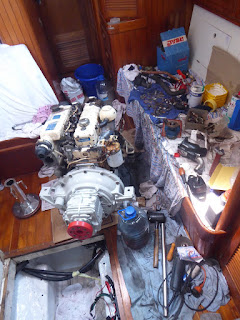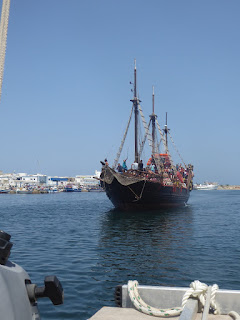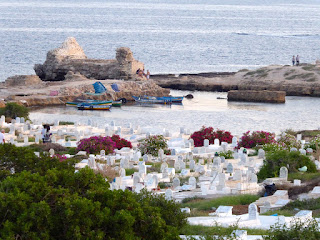Tunisia
2018
Tunisia is a remarkable place. Easy on the cruising kitty, vastly different in culture from most other Mediterranean countries and stifling hot in the summer. It is very dirty and often smelly. We were told that there was seldom litter before the revolution; no one seems to know why it is so now… 99% of the country is Muslim, many women wearing head scarves and long pants in contrast to the tourists who generally dress more western, however it is not uncommon to see women together, arm in arm, one western dressed and the other traditionally clothed.
The men spend their free time at the coffee shops with huge gatherings in the evening. The women ? We were told they go shopping or sometimes to a cafe that is more ‘refined’. Families begin coming out around dark for the promenade; walking along the sea side or sitting in a park. Average annual wages 29,000 - 43,000 dinar = US dollars 10,000 - 18,000…. most of the jobs are filled by men. The women that clean the marina area make about 400 dinar a month! Just over 100 US dollars… a month…
Food is cheap but seasonal and limited. Potatoes, onions, carrots, eyc. Fruit in season, watermelon and apples by the truckload here now. Bread; less than a dinar a baguette = 30 cents! Canned goods in the grocery. Meats include mutton, and goat. Chicken and beef (very tough). Fish. LOTS of fish and some seafood.
We took a couple of tours with fellow Expats, Janice and Bob on Tsamaya, hailing from New York state. They will winter their boat here. We were up to our elbows in sweat and grime with the engine repair so the crew of Tsmaya did all the leg work and arranged for a private van; 2 : 12 hour days. Alaya the driver and tour guide was very knowledgeable on everything Tunisian.
Tour #1

Kairoun; former capital of Tunisia. Also, a trading hub and center for Islamic education. You can also buy carpets there!

Great Mosque (Mosque of Quba) *UNESCO world heritage site; 4th most holy place for islamic religion; 7 trips to the Great Mosque equal one to Mecca. One of the largest in North Africa with a prayer room and a courtyard which is also a cistern capture site.
Mausoleum sidi Sahab for one of Mohammed’s companions; tomb of the Barber. Legend says he always carried 3 hairs from the Prophet’s beard. As we enter the courtyard we heard drums and singing... a small procession was leaving the Mosque lead by a young boy who had just been circumsized...
Mediah. We wandered around the old medina and its side streets. Many of the homes still have enclosed balconies over the street which enabled the women to look out since it was foreboded to be seen in public. We sampled tradition sweets made from chickpea flour with date and nut fillings.








El Jem; Roman amphitheater 238 ad. 35,000 seats. A tunnel runs from El Jem to Mediah (50 km). It was used for transporting animals including lions, tigers and bears (oh my) for the gladiator type fights in El Jem.
Mosaic Museum and the House of Africa. Many of the mosaic found in this region are on display here. While excavating the site in 1990 the archaeologists discover th ruins of a former house, now known as the House of Africa.
Tour #2
Sousse , a sea side city with a large tourist industry as well as fishing.
Old Roman Villa. Foreign encounters. While wandering around the site we saw many catalogued mosaics housed in a long cavernous room then later met Tim. Tim heard our ‘accent’ and asked about it / us. Small world… He is from and lives in Hong Kong but studied at Calvin College just a short drive from our home town…
Carthage is home to the Cisterns of La Malga; built by the Roman’s. Well preserved with a former capacity of over 50,000 cubic meters’ the water traveling through aqueducts from the Atlas mountains which can just be seen in the distance from the site.
Tunis the capital of Tunisia. The revolution started here on 18 December 2010. Civilian Resistant with street demonstrations; 338 deaths and over 2,000 injuries; 3 weeks and 6 days. The result was the ousting of the former president leading to a more democratic society.
The road trip is self was very enlightening. With well maintained roads and highways make driving easy and efficient. At toll booths we saw men selling hot bread (it was delicious) and kids selling kites and pinwheels. One stretch of road there were a half dozen men selling chameleons… hanging by their tails from cords on a long stick. Shepherds and their flocks. Stands selling tuna (prickly pear cactus) and figs. Camel butchers with the awaiting specimens hobbled outside.
Mahfoud and his family continued to embrace us. They prepared many local dishes for us to try, often enough for seconds and thirds. Fresh grilled fish and salad, Tunisian couscous and Pasta with sheep’s stomach stuffed with liver, mutton and many herbs and spices and chickpeas.




To reciprocate with a somewhat American meal for them, we made a stew (tajine) with camel meat camel; because we are in Tunisia, cucumber and tomato salad, garlic bread, apples cooked with cranberries, cinnamon and a touch of sugar (too hot to make a pie), and Rice Krispie bars…

Food of interest not mentioned above: brik; a thin tortilla like shell filled with rough mashed potaoes, capers, onions and an egg (sometimes whole / sometimes scrambled) folded in half and deep fried. CousCous; usually very spicy. Pizza and salads with tuna (everything seems to have tuna fish), Lablabi (chick pea soup with stale bread and harissa and soft boiled egg. Meat on a stick. Pastas… lots of pastas. Shakshaka or Ojja (tomato and egg and sometimes meat / seafood), Marquez (sausages), and Marmuma (a spicy salsa of roasted tomatoes, sweet andhto peppers, onions)

Engine re-build took longer than estimated; of course. But it is in and running strong. Jim is quite happy with the work and the results. The tail end of the refit was tedious. We are still in need of a heat sensor for the engine but it is not available here so we will go on without it and replace it the first opportunity. Aligning the engine to Jim standards, instead of a ‘tired of seeing us’ Tunisian, took a lot of persuading but withholding just a bit of payment help motivate the mechanic. The stainless railing for the cockpit exit area turned out pretty good and is much safer than the original lifelines. The wind generator was shortened so it could be serviced easily and stainless grills were added to the companionway for security. A few welds were reinforced on the bow pulpit as well. And, the Fenders were recovered with durable cloth.














































































No comments:
Post a Comment